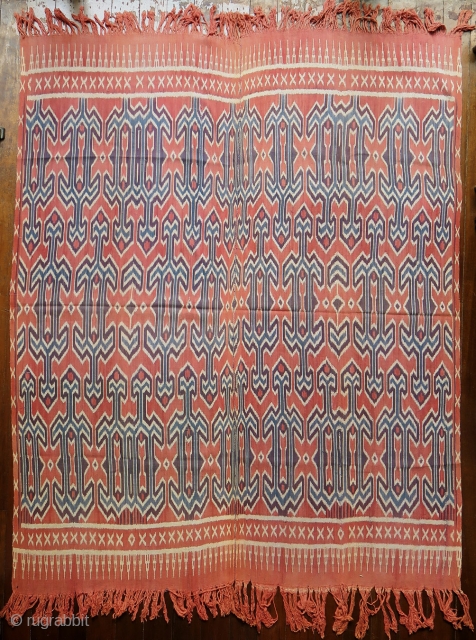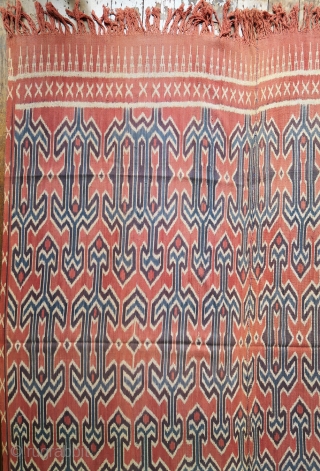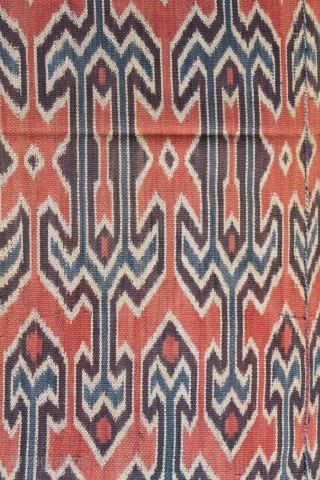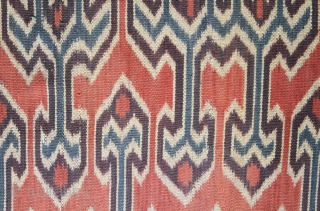Back
Sulawesi | Toraja Funeral Shroud or Hanging (Sekomandi)
Indonesia, central Sulawesi, Galumpang district, 1970s
Handspun cotton, natural and commercial dyes, warp ikat
A graphic funeral shroud (sekomandi) made by the Toraja people in the Galumpang district of Sulawesi, with an ikat pattern in the natural cotton colour, blue, and deep blue-black on a terracotta red ground. The piece is sewn together from 2 identical panels joined together along the selvedges. Its design of interlocking motifs is one of the classic ancient patterns of the Toraja people, sometimes interpreted as a genealogical pattern: the hooked arms and legs of the rhomboid human form representing generations of ongoing social groups (Gittinger, Textiles for this World and Beyond, 97). Due to the relatively smaller scale of the elements (compared with the huge sekong motif, for example) in a densely packed design, the successive layers of outlines in different colours create a 3-dimensional effect.
The centerfield is framed by a single row of simple Xs on all sides; each warp end has a border of pucuk rebung (“bamboo shoots”), and is finished with loosely twisted fringes. Despite this framing, the pattern’s regular repetition with small organic variations have a rhythm that seems to go on endlessly.
Context: The sekomandi is a type of textile regarded as sacred, having originated from divine sources, and belongs to a group of textiles that evolved for use in elaborate ceremonies and rituals to honour the dead—these ceremonies require months or even years of preparation. In the initial stages, the body is kept in the house wrapped in many layers of cloth. Amongst these textiles, the sekomandi can never be missing. When traded elsewhere, it could be used as a skirt or ceremonial hanging. Toraja textiles are breathtaking for their sheer size and scale, and their societal value is indicated by the heavy investment of materials, time, and labour in making them. Similar examples with additional striped side panels are illustrated in Maxwell, Textiles of Southeast Asia, 130, fig. 189; Khan Majlis, Woven Messages, 405, fig. 396.
The textile is in excellent condition, with no stains, tears, or holes. It has a fresh appearance, with warm, soft colour tones and the heavy, robust handspun cotton is crisp and slightly stiff, with a nice grainy texture.
Length: 180 cm, with 14 cm fringes on one end, 7 cm fringes on the other end. Width: 127 cm.
Indonesia, central Sulawesi, Galumpang district, 1970s
Handspun cotton, natural and commercial dyes, warp ikat
A graphic funeral shroud (sekomandi) made by the Toraja people in the Galumpang district of Sulawesi, with an ikat pattern in the natural cotton colour, blue, and deep blue-black on a terracotta red ground. The piece is sewn together from 2 identical panels joined together along the selvedges. Its design of interlocking motifs is one of the classic ancient patterns of the Toraja people, sometimes interpreted as a genealogical pattern: the hooked arms and legs of the rhomboid human form representing generations of ongoing social groups (Gittinger, Textiles for this World and Beyond, 97). Due to the relatively smaller scale of the elements (compared with the huge sekong motif, for example) in a densely packed design, the successive layers of outlines in different colours create a 3-dimensional effect.
The centerfield is framed by a single row of simple Xs on all sides; each warp end has a border of pucuk rebung (“bamboo shoots”), and is finished with loosely twisted fringes. Despite this framing, the pattern’s regular repetition with small organic variations have a rhythm that seems to go on endlessly.
Context: The sekomandi is a type of textile regarded as sacred, having originated from divine sources, and belongs to a group of textiles that evolved for use in elaborate ceremonies and rituals to honour the dead—these ceremonies require months or even years of preparation. In the initial stages, the body is kept in the house wrapped in many layers of cloth. Amongst these textiles, the sekomandi can never be missing. When traded elsewhere, it could be used as a skirt or ceremonial hanging. Toraja textiles are breathtaking for their sheer size and scale, and their societal value is indicated by the heavy investment of materials, time, and labour in making them. Similar examples with additional striped side panels are illustrated in Maxwell, Textiles of Southeast Asia, 130, fig. 189; Khan Majlis, Woven Messages, 405, fig. 396.
The textile is in excellent condition, with no stains, tears, or holes. It has a fresh appearance, with warm, soft colour tones and the heavy, robust handspun cotton is crisp and slightly stiff, with a nice grainy texture.
Length: 180 cm, with 14 cm fringes on one end, 7 cm fringes on the other end. Width: 127 cm.
price:
SOLD
- Home
- Antique Rugs by Region
- Category
- Profiles
- Post Items Free
- Albums
- Benaki Museum of Islamic Art
- Budapest: Ottoman Carpets
- Gulbenkian Museum
- Islamic Carpets. Brooklyn
- Islamic Textiles. Brooklyn
- Konya Museum: Rugs
- MKG, Hamburg
- MMA: Caucasian Carpets
- MMA: Mamluk Carpets
- MMA: Mughal Indian Carpets
- MMA: Ottoman Carpets
- MMA: Safavid Persian Carpets
- MMA: Turkmen Rugs
- McCoy Jones Kilims
- Ottoman textiles. Met
- Philadelphia Museum
- Rugs and Carpets: Berlin
- Seljuqs at the Met
- TIEM, Istanbul: Carpets
- V&A: Classical Carpets
- Vakiflar Carpets: Istanbul
- Baluch Rugs: Indianapolis
- Gallery Exhibitions
- Jaf an Exhibition
- Alberto Levi Gallery
- Andean Textile
- Christie's London: 2016
- Francesca Galloway
- HALI at 40
- ICOC Washington, DC 2018
- Jajims of the Shahsavan
- London Islamic Week April, 2018
- Mongolian Felts
- Navajo Rugs: JB Moore
- Persian Piled Weavings
- SF Tribal & Textile Art Show 2020
- SF Tribal 2019
- Sotheby's: C. Alexander
- Turkish Prayer Rugs
- Turkmen Main Carpets ICOC 2007













